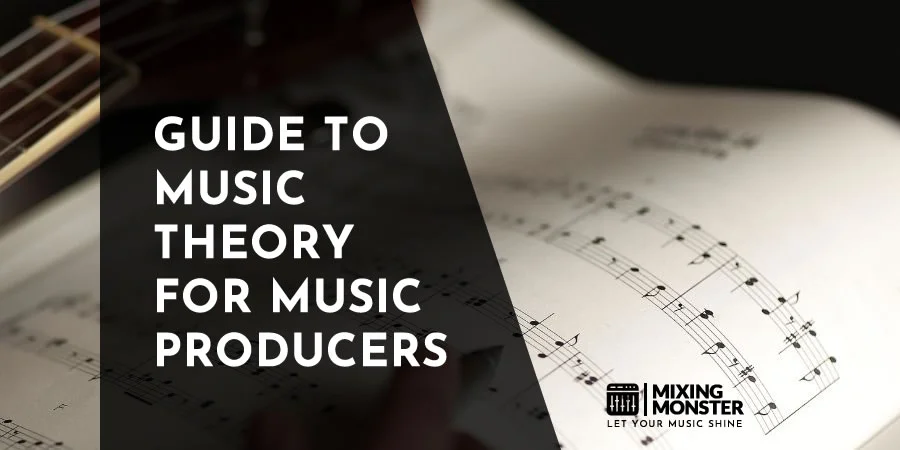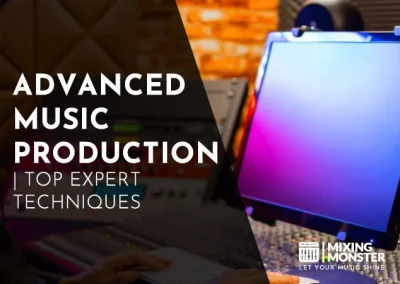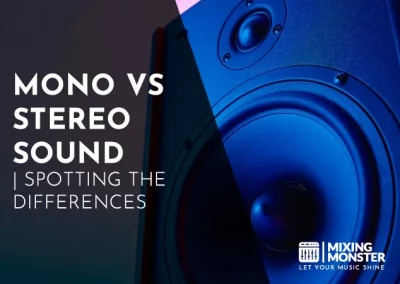Home > Blog > Music > Music Theory
Disclosure: Some of the links below are affiliate links, meaning that at no additional cost to you, we will receive a commission if you click through and make a purchase. Read our full affiliate disclosure here.
Music theory is the foundational language for all music producers, allowing you to translate emotions and ideas into compelling musical elements. This essential toolkit empowers you with the skills to craft intricate beats, melodies, and harmonies, elevating your productions from simple sound arrangements to captivating sonic experiences. Understanding music theory for music producers is not just beneficial; it’s crucial for advancing your craft.
Music theory for music producers encompasses a set of principles and practices that form the backbone of musical creation. It involves learning how scales, chords, and progressions create a harmonious blend. Rhythm, as an element of music theory, provides the timing and pace that drive a piece of music. At the same time, understanding melody and harmony enhances listeners’ emotional connection with your work.
Your continued exploration of music theory will offer the tools to achieve technical expertise and unlock the door to endless creative possibilities. By dissecting the components of song composition and arrangement, understanding the role of production technology, and grasping advanced concepts, you’ll be able to navigate the business of music with confidence and originality. Prepare to dive into an enriching learning experience that will hone your skills, define your musical voice, and possibly reshape your career as a music producer.
KEY TAKEAWAYS:
- Music theory provides the essential language for creating and understanding music.
- Knowledge of music theory enhances production quality and depth.
- Learning advanced concepts in music theory can influence a producer’s success and creativity.
Table Of Contents
1. Foundations Of Music Theory For Music Producers
2. Understanding Rhythm And Beat
3. Developing Melodies And Harmony
4. Exploring Chords And Progressions
5. Song Composition And Arrangement
6. The Role Of Music Production
7. Advanced Music Theory Concepts
8. Music Theory Education
9. The Business And Creativity Of Music Production
10. FAQ

1. Foundations Of Music Theory For Music Producers
Understanding basic music theory is essential for you as a producer to craft complex musical pieces. Here, the focus is on fundamental concepts that are building blocks in music production.
| Entity | Description |
|---|---|
| Notes | The basic sounds in music represented by letters A-G. |
| Keys | Groups of notes that form the basis for compositions. |
| Scales | A sequence of notes in ascending or descending order. |
| Octave | A series of eight notes, where the first and last notes are 12 semitones apart, sounding similar yet higher or lower. |
| Pitch | Determines the highness or lowness of a note, often measured in frequencies. |
| Rhythm | Patterns of beats and rests over time in a piece of music. |
When discussing scales, you’ll encounter the major and minor scales, which have unique sounds of happiness and sadness. The pentatonic scale, with its five-note structure, is favored due to its musical versatility. In contrast, the chromatic scale includes all twelve notes and is essential for creating tension or chromatic movements.
Beats and tempo govern the musical timing, with tempo being the speed at which a piece of music is played. The meter outlines the grouping of beats into measures, and understanding this helps you structure your piece coherently.
Melodies are notes that create a memorable musical line, while harmony deals with the combination of simultaneously sounded musical notes to produce chords and chord progressions. Chords can be simple triads – three-note chords, like the major, minor, or diminished chords.
Most importantly, the circle of fifths is a visual representation that helps us understand critical relationships in music, which is essential for modulating and changing keys.
2. Understanding Rhythm And Beat
In music production, grasping the concept of rhythm and beat is fundamental for creating a compelling musical piece. These elements are the scaffolding around which all other track components are arranged.
Exploring Meter And Time Signature
Rhythm is shaped by a pattern of beats, segmented by measures or bars defined by the time signature. The time signature communicates how many beats are in each measure and what note value (quarter note, eighth note, etc.) is assigned; ordinary time signatures are 4/4, 3/4, and 6/8, among others.
Understanding time signatures will guide you in structuring rhythms correctly and is essential for setting the groundwork for your music.
- Example of 4/4 time: | 1 2 3 4 | 1 2 3 4 |
- Example of 3/4 time: | 1 2 3 | 1 2 3 |
Dynamics Of Beats And Syncopation
Syncopation involves placing emphasis or accents on beats or parts of beats that wouldn’t usually occur, often by using triplets or irregular note groupings to shift the natural accent. This technique can create a sense of movement and excitement within your music.
- Standard beat: 1 2 3 4
- Syncopated beat: 1 2 3 4
Beats and syncopation form a dynamic, interdependent relationship that can alter a track’s energy and flow. Mastering beats will deepen your understanding of rhythm in music production, enabling you to craft tracks that engage and move your listeners.
Consistency in rhythm creates a stable structure, while strategically employing syncopation and beat variations can bring your composition to life.
3. Developing Melodies And Harmony
In this section, you’ll learn how to use scales to build memorable melodies and employ chords to create harmonious progressions that resonate with your listeners.
Building Melodies With Scales
To create engaging melodies, it’s essential to understand scales and modes. Scales serve as the foundation for melody-making. Each scale consists of notes that give your melody a distinct emotional quality.
- Major Scale:
It often conveys a happy or bright mood. - Minor Scale:
Typically, it imparts a sad or contemplative tone. - Modes:
Dorian, Phrygian, Lydian, and more offer a unique sonic flavor.
Start by picking a key and scale for your melody. Your chosen notes will come from this scale. Intervals, or the distance between notes, are crucial in determining your melody’s character.
Experiment with different intervals to see how they change the feel of your melody. Common patterns will emerge as you progress, revealing desirable chord progressions that fit well within the chosen scale.
Crafting Harmony Through Chords
Regarding harmony, the chords bring depth and richness to your music. Chords are built from scales by stacking notes, typically in thirds. Each chord has a root note, which establishes the key of the chord, and additional notes that define its quality, such as major, minor, or diminished.
- Triads:
The simplest form of chords is made up of three notes. - Seventh Chords:
Chords that add a fourth note create a richer and more complex sound.
Your harmony should support the melody and add emotional weight. To craft effective harmony, consider the common chord progressions in the genre you’re working in. For example, the progression I–V–vi–IV is widely used across many styles of music. Always aim for chord progressions that complement and enhance the melody rather than overshadowing it.
4. Exploring Chords And Progressions
In this section, you’ll deepen your understanding of how different chord types convey unique emotions and how to navigate through chord progressions to enhance your musical compositions.
Chord Types And Their Emotions
Chords are the building blocks of music, and their types can significantly influence the emotional impact of a song. Below is a table of common chord types and the typical emotions they might evoke:
| Chord Type | Emotions Conveyed |
|---|---|
| Major Chord | Happiness, brightness, triumph |
| Minor Chord | Sadness, melancholy, introspection |
| Diminished Chord | Tension, instability, unease |
| Triad | The fundamental harmony, can be major or minor |
| Seventh Chords | Depth, complexity, soulfulness |
| Extended Chords | Complexity, color richness, jazziness |
| Inversions | Subtlety, variation, intrigue |
Navigating Through Chord Progressions
Navigating chord progressions is essential for creating a compelling and cohesive musical piece. Progressions are sequences of chords that underpin melodies and give music direction. As you work with progressions, remember:
- Cadences are like punctuation in language; they signal the end of a phrase or section. Moving from the V to the I chord, a perfect cadence gives a sense of resolution, while a plagal cadence (IV to I) feels like a gentle landing.
- Pay attention to common notes between chords and use inversions to create smoother transitions between chords.
- Experiment with extended chords and seventh chords for a more complex sound. They can introduce tension and release, which is crucial for dynamic progressions.
- Mind the key of your composition as it determines the pool of chords available to you and helps construct diatonic progressions that strictly follow the notes within a given key.

5. Song Composition And Arrangement
In this section, you will explore effective songwriting techniques and learn how to structure your song form and arrangement masterfully. This is where your understanding of the language of music transforms into creativity and original compositions.
Songwriting Techniques
To foster your creative process in songwriting, focus on harmonious melody construction and use chord progressions that evoke emotions. You can employ devices such as:
- Repetition And Variation:
Keep your melody and lyrics catchy, yet avoid monotony by introducing slight variations. - Motif Development:
Start with a short musical idea and progressively expand it throughout your piece.
Experimentation plays a pivotal role in music composition. Trust your instincts and be unafraid to blend genres or unconventional chord progressions to instill originality in your work.
Structuring Song Form And Arrangement
The arrangement of your song dictates the listener’s journey. A typical song structure might look like this:
- Intro — Sets the tone of the song.
- Verse — Advances the story or theme.
- Chorus — Serves as the memorable, repetitive peak.
- Bridge — Provides a contrast or a twist.
- Outro — Concludes the song and resolves any lingering tensions.
Your song structure should serve the form and purpose of your music. While the above is typical, exploring unconventional forms can lead to creative breakthroughs. Remember, your arrangement helps communicate your musical ideas effectively; use elements like dynamics and instrumentation to enhance the emotional impact and maintain the listener’s interest.
6. The Role Of Music Production
You engage with a complex blend of technical expertise and creative vision when approaching music production. The role of music production is multifaceted, covering everything from the initial recording to the final touches that prepare a track for release.
Incorporating DAWs And MIDI
Your proficiency with Digital Audio Workstations (DAWs) and MIDI is a cornerstone of modern production. Popular programs like Ableton provide a vast experimental canvas where you can compose, arrange, and tweak your projects. MIDI technology allows you to manipulate notes and controls of virtual instruments, giving you a powerful system to bring your musical ideas to life.
Recording Techniques And Audio Editing
Recording techniques form the backbone of your production quality. As a music producer, understanding microphone placement, acoustic treatment, and signal flow is vital.
Once recorded, audio editing offers control over the raw material, trimming, aligning, and correcting to ensure clarity and impact. You create the desired texture through meticulous editing and convey the intended message through your music.
Music Mixing And Mastering
Mixing and mastering stages are where your tracks transform into polished works. Mixing balances the individual elements, sculpting the dynamic and frequency spectrum for cohesion and musicality.
Mastering then ensures your track translates well across all playback systems, adding the final level of sheen. Your role here is as much about technical precision as it is about applying a consistent vision to the music.
7. Advanced Music Theory Concepts
This section delves into the more complex areas of music theory, focusing on modulation, transposition, and advanced harmonic techniques essential for creating dynamic and expressive compositions.
Modulation And Transposition
Modulation refers to changing the key of a piece of music during the composition. This can add variety and emotional impact to your music. A common tool used in modulation is the circle of fifths, which shows the relationship between keys and can help you navigate through key changes smoothly.
On the other hand, transposition involves moving a piece of music up or down in pitch by a consistent interval. This is particularly useful when adjusting a piece to suit a singer’s vocal range or an instrument’s tuning. Understanding compound intervals larger than an octave is imperative as they frequently appear in transposition.
Exploring Advanced Harmonic Concepts
Advanced harmonic concepts enable you to add depth to your musical creations. You often encounter extended chord structures such as 9th, 11th, and 13th. These chords add layers of harmony that contribute to a more complex sound. The use of these chords adheres to specific rules within music theory.
Chromaticism introduces notes outside the key signature, which can create tension and color within your music. Harmonizing these notes properly requires a solid grasp of key and chordal relationships.
Advanced Music Theory Concepts:
- Modulation
- Transposition
- Circle of Fifths
- Perfect Fifth
- Compound Intervals
- Extended Chords
- Chromaticism
8. Music Theory Education
Acquiring a solid foundation in music theory is essential for your growth as a music producer. With many online resources and software available, you can build and refine your theoretical knowledge to enhance your creative capabilities.
Online Music Theory Resources And Courses
Online platforms offer various music theory courses tailored to varying skill levels. For example, you can explore the Black Keys Music Course on Soundfly, designed to demystify music theory and start with foundational scales.
Another resource, the Composer Class, provides a fundamental guide that helps break down major and minor scales and other music theory essentials.
Additionally, our blog and courses offer guides and articles debating the necessity of music theory in production and tips for better composition.
Music Theory Software And Programs
Various software and programs can significantly enhance your understanding of music theory through practice and application. Below is a list of notable tools that you can utilize:
- Avid’s Sibelius:
This renowned notation program goes beyond notation, allowing you to learn and visualize music theory concepts. - MuseScore:
This free software is excellent for writing music and understanding the practical aspects of music theory. - Hooktheory:
A suite of tools that teaches you music theory by explaining how popular songs are structured. - MusicTheory.net:
Provides straightforward lessons and programs to practice music theory fundamentals.
The right technology can make learning easier and more interactive, helping you translate theory into practical skills in music production.
9. The Business And Creativity Of Music Production
In this section, you will gain insights into the strategic navigation of the music industry and learn how to enhance your creative process in music production. This knowledge is crucial for your growth as a music producer, whether crafting pop music hits or developing a unique sound.
Navigating The Music Industry
As a music producer, you are an integral part of the music business—a dynamic and often complex field. Your ability to understand contracts, recognize revenue streams, and build professional relationships is as important as your technical skills in the studio.
- Start by familiarizing yourself with copyright laws to protect your work and revenue.
- Additionally, network with industry professionals such as label executives, artist managers, and fellow producers. Doing so ensures that your music reaches the right audience and you craft a successful career.
Exploring The Creative Process In Music Production
Your creativity in music production is the signature of your work.
- Experimentation and the creative process define your role as a producer and songwriter, allowing you to create original music that resonates with listeners.
- Push the boundaries of traditional composition by exploring various sound palettes and production techniques.
- Experimentation:
- Try blending genres or unconventional sound sources.
- Use plugins and effects to create textures unique to your sound.
- Creative Process:
- Work closely with songwriters to develop the core idea of a track.
- Be open to revisions as a song moves from concept to finished product.
10. FAQ
1) What are the fundamental concepts of music theory every producer should know?
You should be familiar with keys, scales, and chords, as they constitute the foundation of musical composition. Understanding these concepts allows you to create harmonious melodies and progressions.
2) How can music producers apply music theory in a Digital Audio Workstation?
Music theory provides a framework for arranging compositions within a DAW. By knowing the relationship between scales and chords, you can program MIDI instruments effectively to produce cohesive tracks.
3) Can you recommend reputable resources for learning music theory as a producer?
Many online platforms offer music theory lessons tailored for producers. For example, MusicianStack and Audio Mentor provide targeted insights into music theory’s applications in production.
4) How does understanding music theory enhance the music production process?
With a grasp of music theory, you can make informed decisions about harmony, melody, and rhythm, leading to more expressive and refined productions. It also empowers you to experiment with confidence.
5) What steps can a beginner take to integrate music theory into beat-making effectively?
Start by learning the basics of rhythm and how different notes fit within a scale. Then, experiment with crafting simple chord progressions and melodies in your beats to apply theory practically.
6) What common pitfalls do producers face when learning music theory, and how can they be avoided?
Producers often get overwhelmed by the vastness of music theory. To avoid this, focus on one concept at a time and practice regularly. Using resources like EDM Tips with practical exercises can help solidify your understanding.
















